Our program
St. Nicholas Early Learning, Inc. creates an environment that fosters play and exploration not only in its classrooms with the careful selection of educational yet fun materials, but also in our nature-inspired playground. which was brought to life by generous grants from the National Episcopal Church United Thank Offering, United Way of Central Indiana, and Anthem Blue Cross Blue Shield. Our playground was designed by The Adventurous Child, with a focus on equipment that promotes gross motor play to help fight obesity and encourage exercise as a way to promote health and wellness. The playground is designed to be an outdoor classroom with materials constructed from environmentally-friendly recycled plastic, as well as materials from nature itself in the form of tree stumps and boulders that comprise our obstacle course.
St. Nicholas Early Learning, Inc. is proud of the fact that we achieved Level 2 on Indiana’s Paths to Quality within nine months of opening. From Childcareindiana.org:
“Level 2 Programs have demonstrated a commitment to improve program quality. These programs offer environments that support children’s growth, development, and learning. Level 2 programs will have evidence of a consistent daily schedule, planned activities for children, and will provide relevant program information for families.”
Interwoven between the stimulating environment and the commitment of our caring staff is the innovative blending of both socioeconomic status (SES) and race, which enhances learning, cross socioeconomic dialogue, but most importantly, community building. From the moment you walk through our three doors (we are also committed to creating a safe environment), if the children are playing in our Indoor Play Area, you will be able to feel how close-knit of a community we are.
The quality of our childcare program will be developed and evaluated according to the National Association for the Education of Young Children guidelines, Indiana Paths to Quality program, the Indiana Voluntary Certification Program, and Child Care Development Fund (CCDF) regulations. Our quality program will meet the low child-adult ratios (example four infants to one adult), minimum space requirement of 35 square feet per child, trained staff, curriculum guides for every age, safe sleeping for infants, family education and involvement, and a healthy food program, etc. As stated in these documents a high quality childcare program will provide an environment for infants and toddlers where they will be safe, well supervised, nurtured, nourished, and stimulated with language, sights, sounds, and engaging learning experiences. This can reduce child neglect and delinquency in the future.
In addition, to ensuring low child to staff ratios, and safe environment, the Trinity Childcare Committee is committed to ensuring that, at minimum, 50% of the staff have a Child Development Certificate or higher education degree and that ongoing training for staff and volunteers will ensure that best childcare practices are in place.
Infants
Respectful and responsive caregiving is what happens throughout the day.
Although we are spending most of our time feeding, changing, and helping get to sleep, with each caregiving task we engage and interact and talk with each infant, and we follow their individual schedules. Whenever possible, we read to them, stack blocks (again, and again, and again), and we work on infant sign language. We are building relationships based on trust, which encourages the infants to explore their world more confidently. The infants begin bonding with one another through play, and sometimes their communication with each other can be quite loud.
Toddlers
Routine is introduced by having a daily schedule with set (but flexible) times for outdoor/gross motor play, classroom activities that can be guided by the teacher or discovered through “free play” or choice time.
Many sensory activities are shared with the toddlers because they are still learning how to use their bodies and their senses. They want to touch, taste, smell, see and hear as much as possible, so music and movement plays a big role in their continuously developing language skills. A surge in vocabulary building happens as toddlers near 24 months, so we talk with them as much as possible.
Our toddler program consists of two classrooms: Toddler Ones and Toddler Twos. In our Toddler One classroom, a child must be at least twelve months old and walking, so they still need many opportunities to practice their gross motor skills. They also need several hands on activities, along with many hugs. They love to explore books, but especially love it when one of the teachers explores with them. In our Toddler Twos classroom, we are introducing some teacher-led activities that lead to child-directed experiences as they learn how to treat their friends as well as their environment with respect.
Two-and-a-half to Fours
Literature is the focus in this classroom. Activities are built around themes and stories that are read to the children on a daily basis.
Through books, children are learning numeracy skills, listening skills, how to work in small groups and large groups. This group still needs sensory activities as well – they learn by doing, so the teacher facilitates various learning centers for children to choose from, centers that allow for the practice of dramatic play, science and math skills, building with blocks, fine motor skills, reading and writing. These children want to express themselves more, so art activities are prevalent as well.
